By Bok-Nam Park
Adapted and re-edited by F. Hriadil
Forms should not be taught to students until the fundamental skills are first developed.
“I have water to give to thirsty students. But, unless they have a cup for me to pour it into, they cannot hold the water.”
The “cup” is symbolic of the fundamental skills and principles. The “water” is the complete art of Ba Gua Zhang (Pa Kua Chang). The student has to develop the “cup” before the teacher can pour in the “water.”
When martial arts practitioners ask why I do not teach Ba Gua forms to beginners, I tell the following story.
Living at opposite ends of a remote country village by the sea, there are two families. Each family has a young son. Both of these young boys love to eat fish. In one family, every time the young son wants to eat fish, his father takes out his fishing gear and travels down to the seashore to catch fish for his son to eat. His wife cooks the fish and the family has a nice fish dinner.
In the second family, when the young boy tells his father that he would like to eat fish for dinner, the father takes his son out and shows him how to find materials and construct a fishing pole, line, and hook. He then shows his son how to find and cut bait. Next, he takes his son down by the seashore and shows him the best areas for fishing, shows him how to bait a hook, and teaches him how to catch fish. Once the fish are caught, he takes his son home and shows him how to clean the fish. Then, his wife shows the boy how to cook the fish. The second family then sits down to enjoy a nice fish dinner.
From that time forward,whenever the second family wants to have fish for dinner, father and son go together. Over the course of time, the son learns how to place drop lines, how to fish with nets, how to catch crabs, how to dig for clams, when to use specific kinds of bait, what times of the day are best for fishing, how to fashion lures, etc. The father puts forth a lot of effort to teach his son. After a short time, the son becomes a fairly skilled fisherman. In the first family, the father still goes to catch the fish alone anytime his family wants fish for dinner – because it is just easier and much less time consuming.
A year later, the country is involved in a war and the men of the village are called off to fight. In the first family, the wife know how to prepare and cook fish. But, neither the mother or the son knows how to catch the fish. However, in the second family, the son is now a ble to go catch fish easily on his own and bring it home for he and his mother to eat. Which of the fathers was better?
If a student learns a form without first having a thorough “body knowledge” of the principles on which the form movements are based, he or she is eating the fish without knowing how to catch the fish. Someday, when the teacher is not there to teach more deeply or when the student is called upon to apply the art in a fighting situation, he or she will be out of luck. The goal of any true teacher of Ba Gua Zhang is to teach the student “how to fish.”
While many students today are taught forms as the sum and total of the art, forms practice in fact comprises only a small part of the entire art of Ba Gua Zhang. There are many elements that cannot be developed through forms practice.
Fixed forms practice does help a student learn some aspects of continuity, fluidity, connection, body integration, and rhythm. However, there are two key elements missing from any fixed forms practice:
- Sufficient repetition of individual body methods
- Variation.
Unless students practice the fundamental methods, they will never reach a high level of understanding and mastery. And, unless students learn how to change, adapt, and vary their movements spontaneously, their fighting skill will always be weak. Both of these elements are essential.
It must also be understood that all variation of movement and technique must still adhere to the fundamental principles of Ba Gua Zhang. To this end, the body is trained and developed so that the proper response becomes automatic. It becomes a reflex and derives from the habits which are ingrained in the body. These correct habits are formed through the repetition of the fundamental individual body training methods.
Beyond building correct habits and body mechanics, repetition of the fundamental training methods serves another very important purpose – overall body development. The “internal” styles of the Chinese martial arts are famous for the practitioner’s ability to deliver a tremendous amount of power with very little visible movement or apparent effort. The Chinese refer to the highest level of this ability as Hua Jing (Hua Ching).
Hua Jing is one of the three levels of Jing (Ching), or trained power/strength. They are:
Ming Jing

Translated as “obvious power.” This means that exertion of force, alignment, and the effects of the body’s action are all clearly discernible to an observer.
An Jing

Translated as “hidden or covert power.” When force is exerted through this method, its origin is not visible to the untrained observer. The practitioner at this level has begun to refine and internalize the body’s movement.
Hua Jing

Translated as “refined force or mysterious power.” Here, the practitioner’s application of force is so subtle that the origin of this force is completely imperceptible. When the force is exerted, one’s opponent cannot feel the source of where the force is coming from. Typically, a skilled martial artist will utilize sensory cues to “listen to” or “feel” the movement and energy of an opponent’s body in order respond correctly to any attack. But, the practitioner who has reached the Hua Jing level of development has completely internalized his or her movements. At this level, the practitioner moves so subtlely and efficiently that the movements are undetectable even if the opponent is touching the practitioner’s body. And, even though the movements are very small, smooth, and subtle, they are extremely powerful.
A practitioner cannot jump right to the An Jing or Hua Jing level of development without first spending a considerable amount of time practicing at the Ming Jing level. The reason is that real power has to be developed before it can be hidden and refined. If a student simply tries to imitate the movements of an instructor who has reached the An Jing or Hua Jing level of develpment, he or she will not make very good progress.
In order to develop the An Jing or Hua Jing ability, the practitioner’s body must first be properly cultivated. The development process is a progressive one. In the Ba Gua Zhang method of Lu Shui-Tian, the Ming Jing level of development is comprised of a specific series of fundamental training methods which are designed to:
- increase the range of motion of the joints
- increase the body’s flexibility
- condition the muscles, tendons, ligaments, and bones
- develop the proper body and movement mechanics
- coordinate the movement of the entire body
- integrate the mind and the breath with the body
- develop internal power
- develop speed and endurance
- develop the practitioner’s automatic reflex responses
- infuse Ba Gua’s fundamental principles into the practitioner’s body knowledge
It takes many hundreds of hours of correct practice of the individual body methods at the Ming Jing level to properly condition the practitioner and establish the necessary fundamentals. Only then is it appropriate to introduce forms to the student.
The increased levels of flexibility and suppleness lead to increased Qi (Chi) movement. The development of secondary muscle groups, ligaments, tendons, and joints leads to increased body strength, coordination, and integration. The development of the mind’s intention and focus leads to an increased body awareness and a connection between the mind, body, and nervous system. If these elements have not been progressively developed and fully trained, a practitioner can perform a form movement perfectly, with all of the correct body motions and alignments, yet still not have any true internal power. The movement will be “empty.”
In the method of Lu Shui-Tian, forms are used to refine the skills that have already been developed through the fundamental basic training methods. Practitioners who have only done forms practice will never progress very far in terms of internal power development or fighting skill. Their form may “look” graceful or their movement may “look” skilled, but it will lack true internal content. It will lack internal power and martial depth.
With a sound and developed “body knowledge” of the principles and methods of Ba Gua Zhang, students can easily learn, understand, and execute the movements in any Ba Gua form. The movements will then have true martial integrity and real internal content. And, it will be a relatively straightforward matter for the students to understand how to vary specific techniques according to Ba Gua principles through the correct adjustment of the various hand, body, and/or footwork methods. Finally, without a strong foundation built upon hundreds of hours of practice in a comprehensive, systematic, and progressive training program like that comprising the Ba Gua method of Lu Shui-Tian, the body will not become fully developed, and will not be able to respond innately and spontaneously in any given fighting situation.

